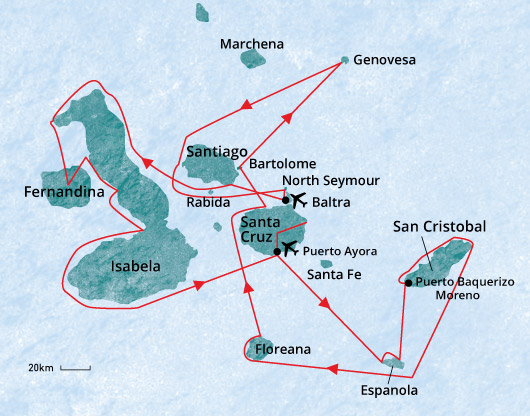
Galapagos Islands 15 day Cruise
STYLE: LUXURY – EXPEDITION
Galapagos Island Cruises range from 5 days to 15 days in duration. On a luxury or first-class Galapagos cruise you will visit many of the islands where you will participate in short walks, snorkelling, Zodiac (Panga) cruising and kayaking as well as visiting the Giant Tortoise Breeding Centre. Boats range in size from 16 to 90 guests. We have first-hand knowledge of many boats and the vest operators.
Each boat has its own itinerary, agreed with the Galapagos National Park. The itinerary show here is just one example. For more information please visit our Specialist South America web site; where you will fin much more information about the boats.

ITINERARY SUMMARY
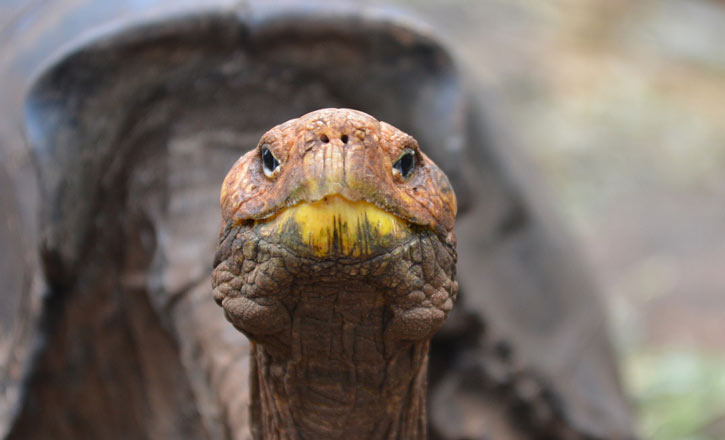
DAY 1 ARRIVE BALTRA AIRPORT GALAPGOS ISLANDS
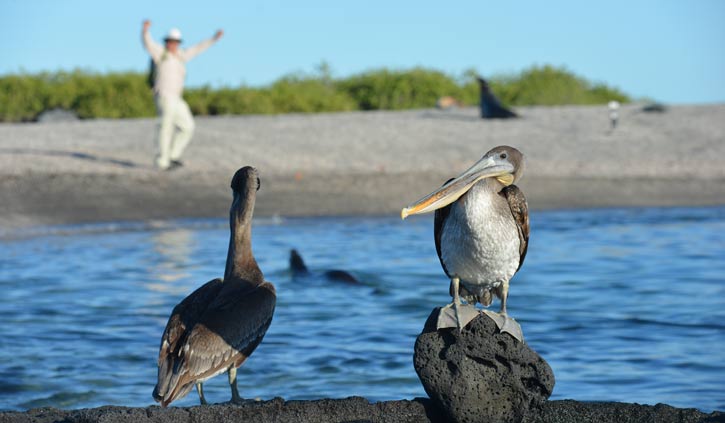
Arrive at Baltra Island Airport and transfer to the Ocean Spray.
Sail for Sombrero Chino (Chinese Hat), named for its volcanic rock shape. View Galapagos wildlife and birds, specifically American oystercatchers, Galapagos penguins, and Sally-Lightfoot crabs as they skirt across the rocks.
DAY 2 ISABELA & FERNANDINA ISLANDS
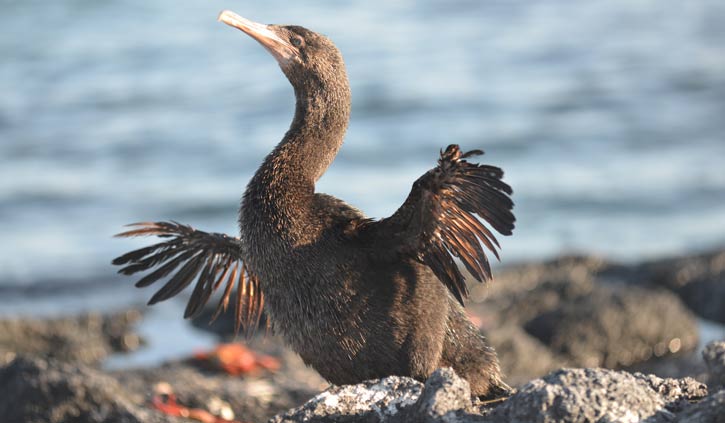
Travel to Isabela, the Galapagos archipelago’s youngest and most volcanically active island, and visit Vicente Roca Point. Comprised of two separate coves, Vicente Roca is a large bay with spectacular sea life. Seahorses, sea turtles, and Mola-mola are abundant in the water.
In the afternoon, sail for Fernandina. This island was never invaded by foreign animal species, making it one of the most pristine eco-systems in the world. Take a short hike to the Flightless Cormorant nesting site and view the volcano La Cumbre. Throughout the day, snorkle in the clear, blue waters of the Galapagos.
DAY 3 ISABELA ISLAND, TAGUS & URBINA BAY
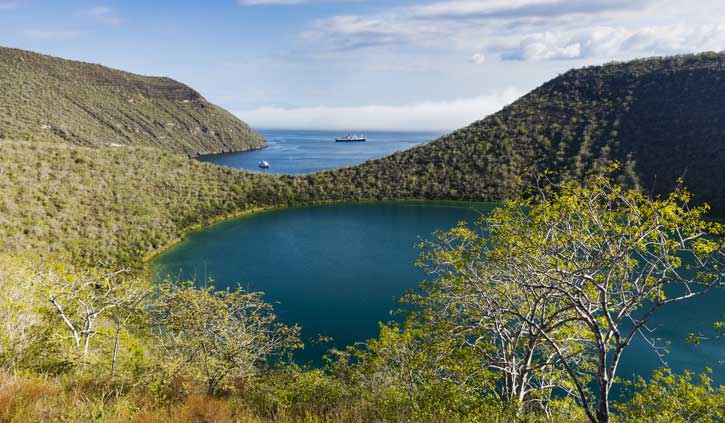
Tagus Cove is located across from Fernandina Island, near the Bolivar Channel dividing the two islands. This spot has been frequented by ships since the 1800s, using the area as an anchorage site. Trails winding by Lake Darwin up to a ridge display wonderful views. Punta Tortuga, just north of Tagus Cove, is another lovely beach surrounded by mangroves.
Urbina Bay is located at the base of Alcedo Volcano on the west coast, between Tagus Cove and Elizabeth Bay. This area experienced a major uplift in 1954, causing the land to rise over 16 feet. The coast expanded half a mile out, leaving marine life stranded on the new shore. This area is also a great place for snorkeling.
DAY 4 ELIZABETH BAY & MORENO POINT (ISABELA ISLAND)
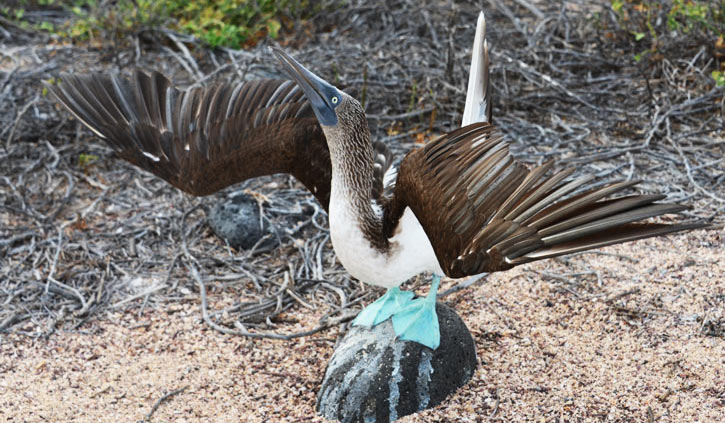
Elizabeth Bay is located on the east coast of Isabela Island. The bay contains many islets, which can be visited by dinghy. Penguins and Blue-footed Boobies can be spotted on the rocky islets. With an abundance of marine life and clear water, the area is perfect for snorkeling and viewing schools of colorful fish, sea lions, and perhaps even sharks.
Moreno Point is located near Elizabeth Bay on the west coast of Isabela Island. The plethora of birds seen during a dinghy ride along the striking rocky shores or a hike along path through lava rock leading to tide pools and mangroves create a birdwatcher’s delight. In the tide pools green sea turtles or white-tip sharks can be spotted.
DAY 5 SANTA CRUZ
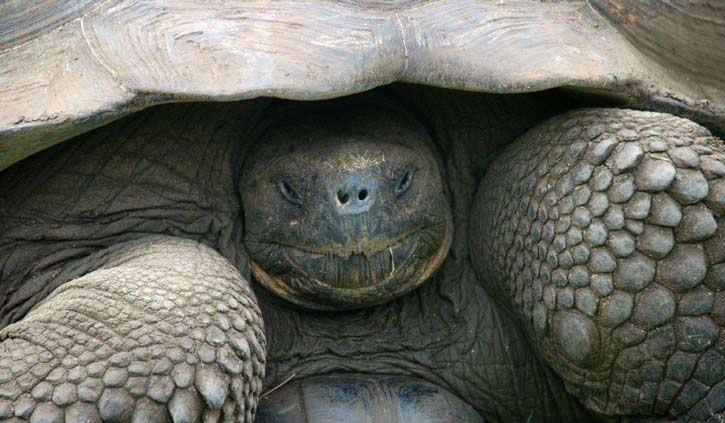
Visit the Charles Darwin Research Center to view Galapagos tortoises ranging between 3 inches to over 4 feet long!
After lunch, take off for the Santa Cruz Highlands to walk along a path and observe the hills, ferns, volcanoes, and rich wildlife. Explore the underground lava tubes with local guides.
DAY 6 SOUTH PLAZA
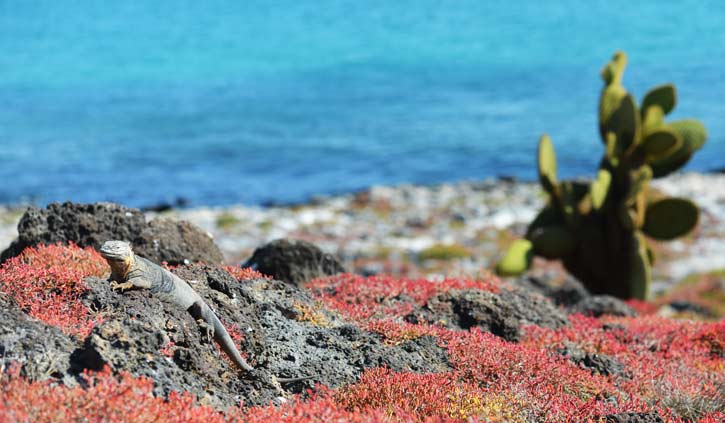
Head to South Plaza Island to view one of the largest sea lion colonies and colorful yellow and red land iguanas. This small island features steep cliffs which were formed by rising lava. The ground is now covered by Opuntia cacti. Take a short hike around the island’s unique landscape.
DAY 7 ESPANOLA ISLAND
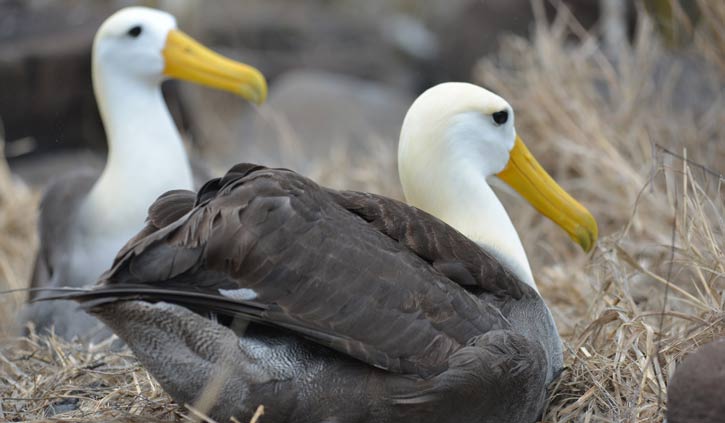
Sail to Suarez Point, a magnificent location for spotting Blue-footed Boobies, albatrosses and Nazca Boobies. The most famous attraction is the island’s magnificent blowhole, which spurts water high into the air. Take a hike around the island.
In the afternoon, visit Gardner Bay, the breeding site of most of the world’s 12,000 pairs of Waved Albatrosses. The bay is surrounded by white sandy beaches with a myriad of sea lions, making it a great snorkel site.
After landing, you can walk across a lovely white sand beach amongst a busy sea lion colony or dive into the water to swim with sea lion pups. This small island is a marine visit where you can enjoy fantastic snorkeling and swimming.
DAY 8 SAN CRISTOBAL ISLAND
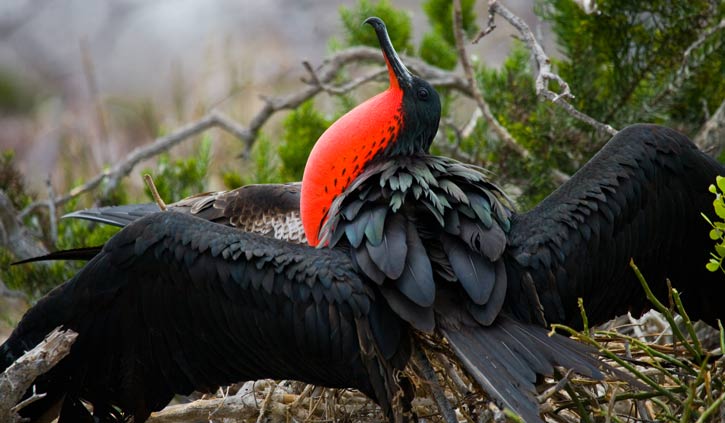
The Interpretation Center was opened in 1998 as a phase of the project “Interpretation and Environment Education Project.” Visitors enjoy expositions on natural history, human history, and conservation. The conservation efforts represent the movement to protect the wildlife and natural environment through means of population and tourist control. The Interpretation Center has an outdoor stadium, audio-visual equipment, and meeting rooms.
A visitor site in the southeast part of San Cristobal Island that can be reached in roughly one hour by road from Puerto Baquerizo Moreno. On the trees and shrubs surrounding the site, you may see land birds like warbler, finches and mockingbirds, and on the trails, Giant Tortoises.
Isla Lobos or Lobos Island is named after the sea lions that rest and play on its rocky shores. It is also home to blue-footed boobies, great frigate-birds, brown pelicans, lava gulls, common noddies, yellow warblers and small and medium ground finches. There is good snorkeling in the clear waters of the channel and this is one of the best sites at which to swim with sea lions underwater.
This striking rock formation is located a couple hours off the western shore of San Cristobal. Jutting out of the water, the rocks stand vertically at hundreds of feet above the ocean divided by a small channel. Although there are no landing areas, kayaking and scuba diving allow visitors to spot a variety of marine life.
DAY 9 SAN CRISTOBAL ISLAND
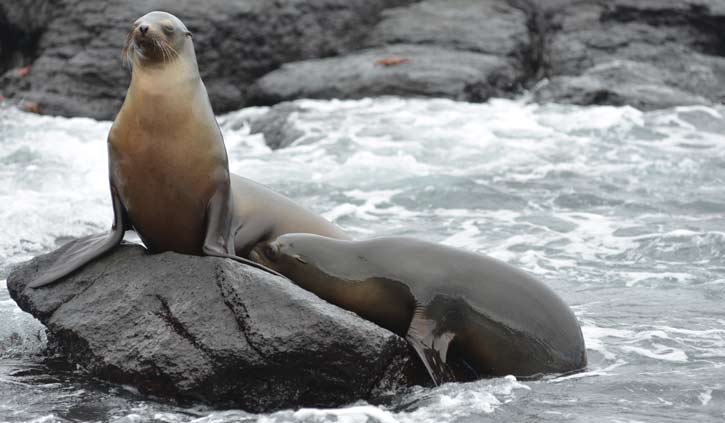
Sail to Pitt Point and take a hike up a cliff which leads you through a ravine. This hike leads travelers to an abundance of birds. View the sea lion colony and swim in the warm waters. In the afternoon, explore Witch Hill and relax on its picturesque white-sand beaches.
DAY 10 FLOREANA ISLAND
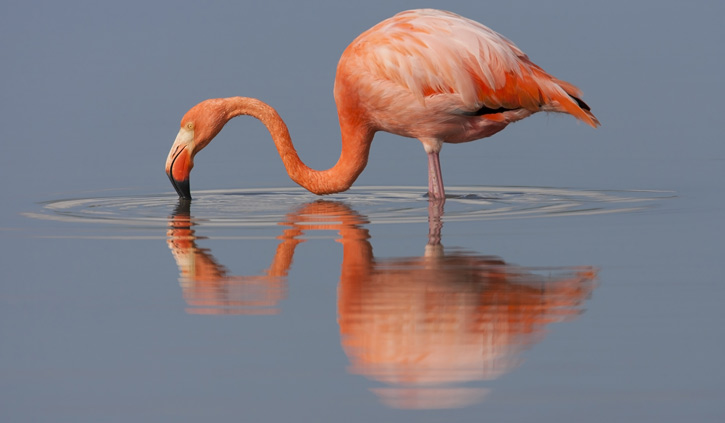
Visit Post Office Bay, famous for its wooden barrel which posed as an unofficial mail box in the 18th century. The tradition has continued to today, as travelers leave addressed postcards in the barrel and sort through left mail to deliver those close to home.
In the afternoon, visit Cormorant Point, the site of a large flock of flamingos. Relax on one of the beaches, aptly named for the color of their sands.
One of the best snorkeling sites in the Galapagos, this volcanic crater has been eroded by the waves leaving the northern and southern sides poking out of the water. The coral reef in the middle is perfect for attracting marine life. Snorkelers enjoy the variety of marine life and exciting currents that rush through the crown, creating an exhilarating experience.
DAY 11 SANTA CRUZ ISLAND
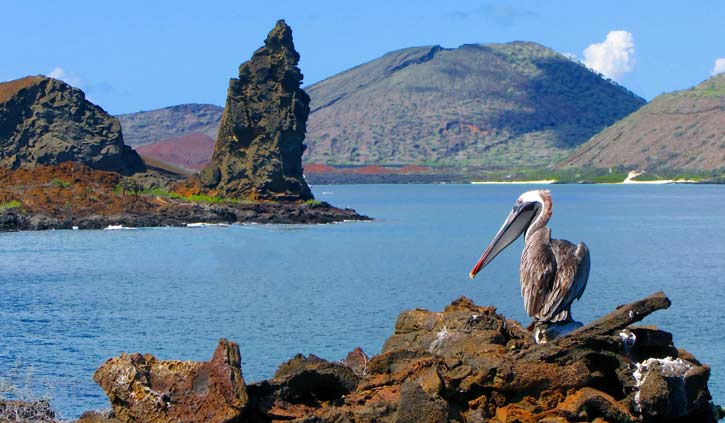
In the morning, visit Black Turtle Cove by dinghy and admire the Blacktip and whitetip reef sharks, sea turtles, and a variety of rays which are often spotted here. The calm and secluded location of the cove makes it a safe haven for young marine life.
Home of the famous Pinnacle Rock, Bartholomew consists of an extinct volcano with a variety of red, orange, black and even green volcanic formations. A trail of stairs leads to the summit of the volcano, boasting one o the best views of the islands. The beach is perfect for snorkeling and possible sightings of the Galapagos Penguin.
DAY 12 GENOVESA ISLAND
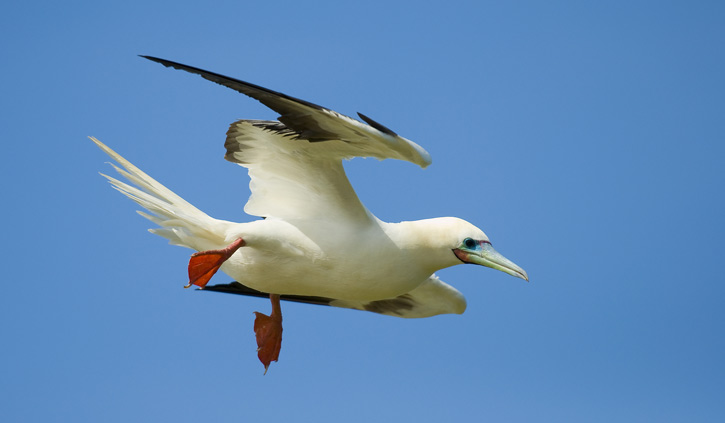
Set sail for Darwin Bay and land on its white-sand coral beach. Take a half-mile trail through the mangroves and view Nazca Boobies, Red-footed Boobies, and Swallow-tailed Gulls. Tidal pools are teeming with young sea lions and reef fish, and the occasional hammerhead shark can be found among the rocks.
Head for El Barranco, also known as Prince Phillip’s Steps. Hike up the rocky face and reach the top of a cliff where you can see Red-footed Boobies, Short-eared Lava Owls, Galapagos Swallows, and Galapagos Doves.
DAY 13 SANTIAGO ISLAND
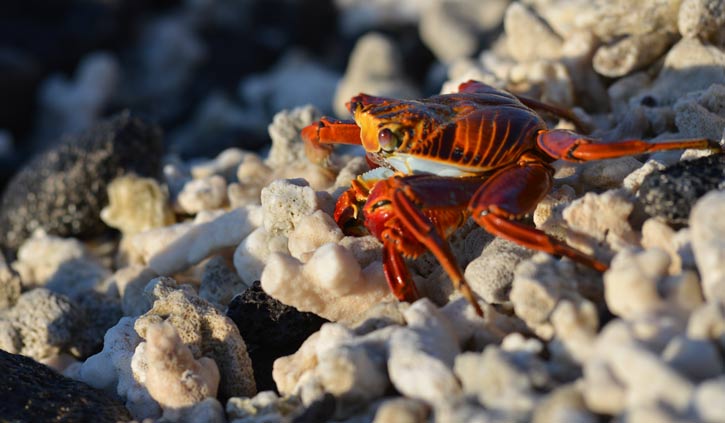
Travel to Espumilla Beach, a popular location for viewing marine iguanas and Sally Lightfoot Crabs. Grab a snorkel and view octopi, moray eel, and sharks in the water.
From Espumilla, set sail for Egas Port and view Galapagos Hawks and Quick-footed Galapagos Lava Lizards. Take a trail across the coastline and view tidal pools and grottos which are home to Galapagos Fur Sea Lions. Snorkel in the clear pools or relax on the beach.
Years ago Buccaneer Cove was a safe haven where pirates in the 1600 and 1700’s would stake out on the Northwestern side of Santiago Island. Sea turtles now take the pirates place and dig their nests for their eggs near the Mangrove trees. It is a great location for snorkeling and many marine birds and sea lions can be found here.
DAY 14 NORTH SEYMOUR & SANTA CRUZ ISLANDS
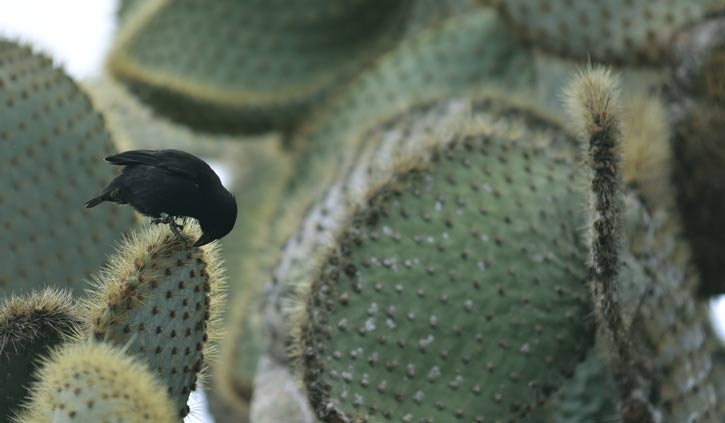
Visit North Seymour Island to swim with Galapagos Sea Lions. The island is known for its arid and rocky landscape.
In the afternoon, travel to the Santa Cruz Highlands. Take a path along the island and observe the hills, ferns, volcanoes, and rich wildlife. Home to giant tortoises, forest, mockingbirds, Bahama ducklings, White-cheeked Pintail ducklings, Darwin finches, and many other species, The Santa Cruz Highlands delights travelers with its diverse fauna. Explore the underground lava tubes with your guide.
DAY 15 MOSQUERA ISLET & BALTRA AIRPORT
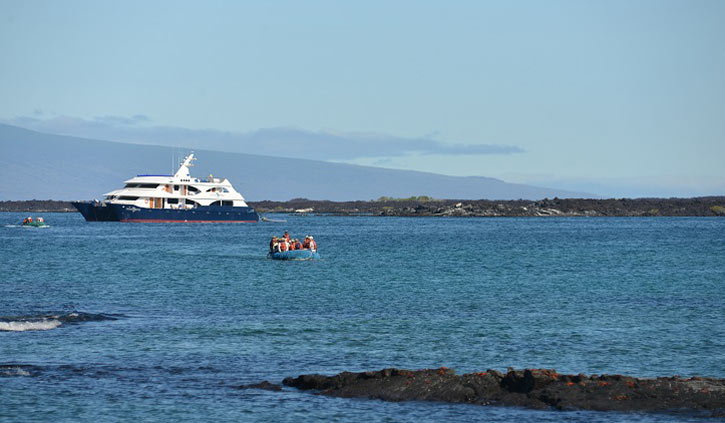
Journey to Mosquera Islet, a reef of rocks and coral. This islet houses one of the largest populations of sea lions and many sea birds make their nests along the rocky shore.
Transfer to the airport and return to the mainland.



